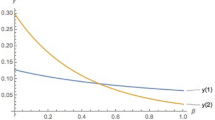Abstract
In a two-stage oligopoly, with investment in the first stage and quantity or price competition in the second stage, there is a “Common Wisdom” Theorem which states that we find over-investment if the goods are substitutes and competition is in strategic substitutes, or if goods are complements and competition is in strategic complements, and that we find under-investment if we have complements and strategic substitutes or substitutes and strategic complements. The existing literature, however, lacks a proof of this theorem and, in particular, it lacks a systematic comparison of the different benchmarks for over- and under-investment. A “naive” benchmark is the cost efficient investment with respect to the subgame perfect (closed loop) equilibrium quantities. Alternative benchmarks (which are more often proposed) are the open loop equilibrium investment or the welfare maximizing investment. The chosen benchmark is critical because the Common Wisdom Theorem applies (under certain conventional conditions) only for the naive benchmark. The other two benchmarks give rise to subcases.
Similar content being viewed by others
References
Athey S, Schmutzler A (2001) Investment and market dominance. Rand J Econ 32(1): 1–26
Besley T, Suzumura K (1992) Taxation and welfare in an oligopoly with strategic commitment. Int Econ Rev 33(2): 413–431
Bolle F (2008) Over- and under-investment according to different benchmarks. Discussion paper 265, Europa-Universität Viadrina
Bolle F, Breitmoser Y (2004) Dynamic competition with irreversible moves: tacit collusion (almost) guaranteed. Discussion paper 207, Europa-Universität Viadrina
Brander JA, Spencer BJ (1983) Strategic commitment with R&D: the symmetric case. Bell J Econ 14(1): 225–235
Bulow JI, Geanakopolos JD, Klemperer PD (1985) Multimarket oligopoly: strategic substitutes and complements. J Political Econ 93: 488–511
d’Aspremont C, Jacquemin A (1988) Cooperative and noncooperative R&D in duopoly with spillovers. Am Econ Rev 78(8): 1133–1137
Dasgupta P, Maskin E (1986) The existence of equilibrium in discontinuous Economic Games, I: Theory. Rev Econ Stud 53: 1–26
Dixit A (1986) Comparative statics for oligopoly. Int Econ Rev 27: 107–122
Elberfeld W (2003) A note on technology choice, firm heterogeneity and welfare. Int J Ind Organ 21: 593–605
Fudenberg D, Tirole J (1984) The fat-cat effect, the puppy-dog ploy, and the lean and hungry look. Am Econ Rev 74: 361–366
Fudenberg D, Tirole J (1993) Game theory, 3rd edn. MIT Press Cambridge, Massachusetts
Grant S, Quiggin J (1996) Capital precommitment and competition in supply schedules. J Ind Econ 22(4): 427–441
Kamien MI, Muller E, Zang I (1992) Research joint ventures and R&D cartels. Am Econ Rev 82(5): 1293–1306
Long NV, Soubeyran A (2001) Cost manipulation games in oligopoly, with cost of manipulating. Int Econ Rev 42(2): 505–533
Murphy FH, Smeers Y (2005) Generation capacity expansion in imperfectly competitive restructured electricity markets. Oper Res 53(4): 646–661
Okuno-Fujiwara J, Suzumura K (1993) Symmetric Cournot oligopoly and economic welfare: a synthesis. Econ Theory 3: 43–59
Palander TF (1939) Konkurrens och marknadsjämvikt vid duopol och oligopoly. Ekonomisk Tidskrift 41:124–145, 220–250
Sacco D, Schmutzler A (in press) Is there a U-shaped relation between competition and investment? Int J Ind Organ
Schmutzler A (2010) The relation between Competition and Innovation—why is it such a mess? Working paper no. 0716 (revised version)
Shapiro C (1989) Theories of oligopoly behavior. In: Schmalensee R, Willig RD (eds) Handbook of industrial organization, vol 1, pp 330–414
Somma E (1999) The effect of incomplete information about future technological opportunities on pre-emption. Int J Ind Organ 17(6): 765–799
Spence M (1977) Entry, capacity, investment and oligopolistic pricing. Bell J 10: 1–19
Suzumura K (1992) Cooperative and noncooperative R&D in oligopoly with spillovers. Am Econ Rev 82: 1307–1320
Stanford WG (1986) Subgame perfect reaction function equilibria in discounted duopoly supergames are trivial. J Econ Theory 39: 226–232
Theocaris RD (1959) On the stability of the Cournot solution on the oligopoly problem. Rev Econ Stud 27: 133–134
Tseng M-Ch (2004) Strategic choice of flexible manufacturing technologies. Int J Prod Econ 91: 223–227
Vetter H (2007) Taxes versus permits in a two-stage duopoly. B E J Theor Econ 7/1:article 17
Vives X (1989) Technological competition, uncertainty and oligopoly. J Econ Theory 48: 386–415
Vives X (2000) Oligopoly pricing. MIT Press, Cambridge
Vives X (2008) Innovation and competitive pressure. J Ind Econ 56(3): 419–469
Wang XH, Zhao J (2010) Why are firms sometimes unwilling to reduce costs?. J Econ 101(2): 103–124
Author information
Authors and Affiliations
Corresponding author
Electronic Supplementary Material
The Below is the Electronic Supplementary Material.
Rights and permissions
About this article
Cite this article
Bolle, F. Over- and under-investment according to different benchmarks. J Econ 104, 219–238 (2011). https://doi.org/10.1007/s00712-011-0218-8
Received:
Accepted:
Published:
Issue Date:
DOI: https://doi.org/10.1007/s00712-011-0218-8




